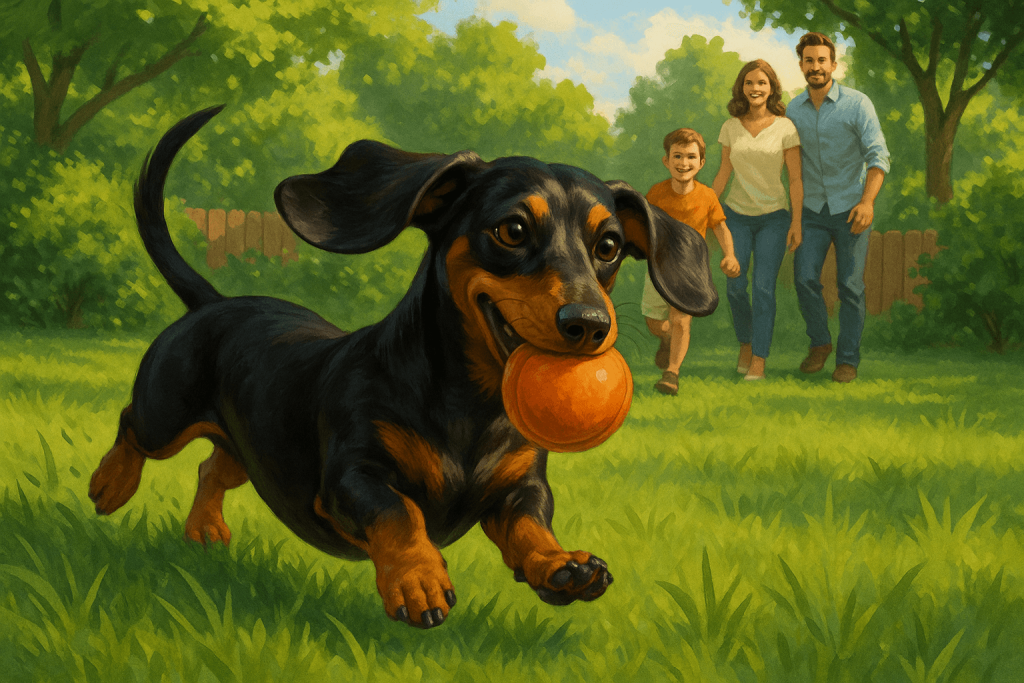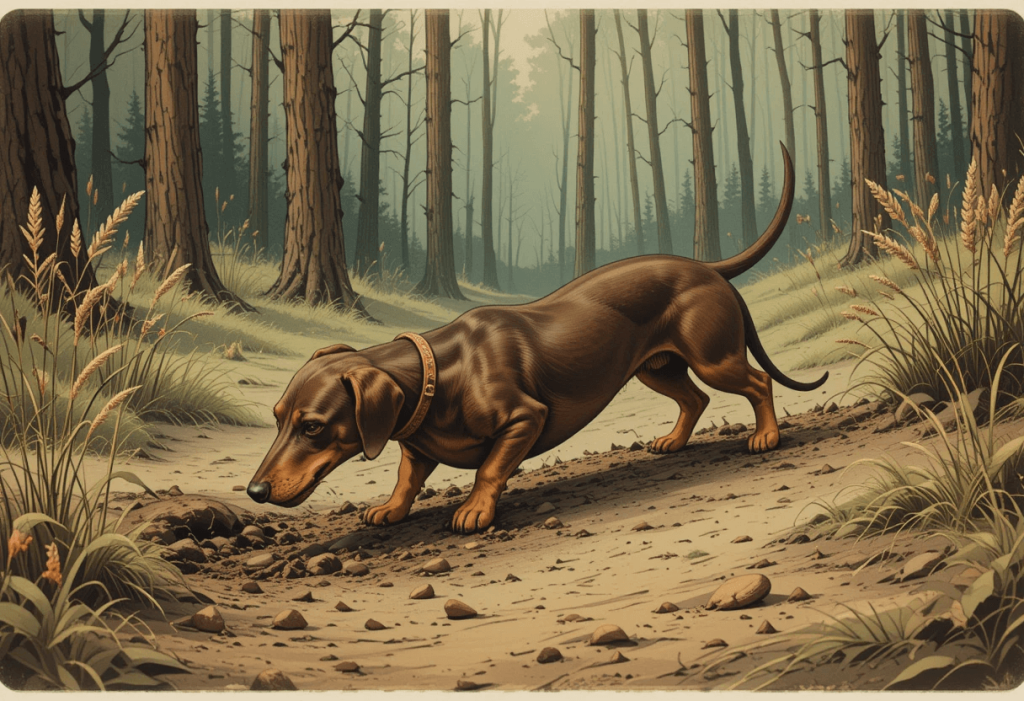Introduction
The Dachshund, a dog breed beloved for its long body, short legs, and unique appearance, has captured the hearts of dog lovers worldwide. Often affectionately referred to as “wiener dogs,” these dogs are not only adorable but also have an interesting history that dates back several centuries. Their origin story is rooted in their function as hunting dogs, specifically bred to hunt small game like badgers. Over time, the Dachshund has transitioned from a working dog to a beloved companion pet in many households. But how did these small dogs evolve from fierce hunters to the cuddly companions we know today? Let’s take a deep dive into the history and origin of the Dachshund breed.

The Origins of the Dachshund Breed:
The Dachshund’s history traces back to ancient Germany, where the breed was developed for a very specific purpose: hunting. The name “Dachshund” is a German word that translates to “badger dog” – a perfect description of their original role. These dogs were bred to burrow into the dens of badgers, flush them out, and hold them at bay until their human handlers arrived.
The breed’s origins are believed to date back to the 15th century, although it is likely that they have ancestors from even earlier. Some historians speculate that the breed may have been a cross between hounds and terriers, designed to bring together the stamina and strength of a hound with the tenacity and digging ability of a terrier.
A Dog Built for Burrowing:
What truly sets the Dachshund apart is its long, low body and short legs, which make it perfectly suited to burrow underground. These physical characteristics allowed the dog to chase small game into burrows, making it an ideal companion for hunters who pursued burrowing animals like badgers, rabbits, and even foxes. Their powerful front legs and deep chest made them excellent at digging, while their elongated shape ensured they could get into tight spaces.
The Dachshund’s unique conformation was also advantageous in another way: they were small enough to navigate narrow tunnels and hide away from larger predators, yet strong enough to fight off the prey they encountered underground.
The Evolution of the Dachshund in Germany:
While the breed’s origins are firmly planted in the German countryside, Dachshunds became more widely recognized across Europe by the 17th century. During the 18th century, these dogs were developed in different sizes to accommodate different types of hunting. Originally, Dachshunds came in one standard size, but over time, hunters began to breed them in three distinct sizes: standard, miniature, and toy. These size variations made the Dachshund adaptable to hunting a variety of small game, from rabbits to foxes.
In fact, the miniature Dachshund was bred to hunt smaller animals like rabbits, while the standard version was used for larger prey like badgers. The smaller dogs were also often used by noble families for sport hunting, further elevating the breed’s status in European society.

Dachshund’s Popularity Across the World:
As the breed gained recognition in Germany, it soon spread to other parts of Europe and beyond. It was in the 19th century when the Dachshund first made its way to the United States, where it was recognized by the American Kennel Club (AKC) in 1885. The breed quickly became popular for its unique looks and charming personality, with many families falling in love with their loyal, affectionate, and fearless nature.
During the early 20th century, Dachshunds gained a strong foothold in American homes, and their reputation as excellent pets began to take precedence over their original role as hunting dogs. This shift was especially evident in the post-World War I and World War II eras, when Dachshunds were embraced as family companions.
Dachshund in Popular Culture:
Over the years, Dachshunds have made their way into popular culture. Their distinct appearance and playful demeanor have earned them numerous appearances in movies, TV shows, and advertisements. Famous Dachshunds, such as “Spunky” from the animated series Rugrats and “Elliott” from the movie The Adventures of Rocky and Bullwinkle, have solidified their status as lovable, quirky pets.
In addition to their Hollywood fame, Dachshunds have also become the face of many marketing campaigns and even celebrity pets. The Dachshund’s easygoing personality, coupled with its affectionate nature, makes it a natural fit for family life, and its continued presence in pop culture is a testament to the breed’s enduring appeal.
Modern Dachshund as a Companion Animal:
Today, the Dachshund is more often seen as a companion animal than as a working dog. Their playful and affectionate personality has made them a favorite of families, singles, and seniors alike. They are known for their loyalty, intelligence, and sense of humor. Despite their small size, they possess a confident and sometimes stubborn attitude that reflects their origins as hunters.
Although they were bred for hunting, most modern Dachshunds are more likely to be found lounging on a couch or playing in the yard than chasing badgers. Nonetheless, their hunting instincts are still strong, and they may try to dig or chase smaller animals if given the opportunity.
Conclusion:
The Dachshund’s history is rich, fascinating, and deeply tied to its role as a hunting dog. From its humble beginnings as a badger hunter in Germany to its current status as a cherished family pet, the breed has evolved significantly over the centuries. Whether you’re admiring a Dachshund’s long, sleek body or enjoying its playful, spirited personality, it’s clear that this breed has earned its place in the hearts of millions around the world.
FAQs:
- What was the original purpose of the Dachshund?
The original purpose of the Dachshund was to hunt small game, particularly badgers. They were bred to burrow into dens and flush out their prey. - Why do Dachshunds have short legs?
Dachshunds have short legs to help them burrow into the ground and chase prey into tunnels. Their long bodies and short legs make them perfect for digging and squeezing into tight spaces. - Are there different types of Dachshunds?
Yes, Dachshunds come in three sizes: standard, miniature, and toy. Each size was developed for different hunting purposes, with the standard size used for larger prey and the miniature for smaller animals. - When did the Dachshund become popular as a family pet?
While the Dachshund was initially bred for hunting, it became popular as a family pet in the early 20th century, especially after World War I and World War II. - How long do Dachshunds typically live?
Dachshunds generally live between 12 to 16 years, with some reaching even older ages with proper care. - Are Dachshunds good with children?
Yes, Dachshunds are generally good with children and other pets, though they can be somewhat independent and stubborn at times. Early socialization is key to ensuring they are well-behaved.
Leave a Reply